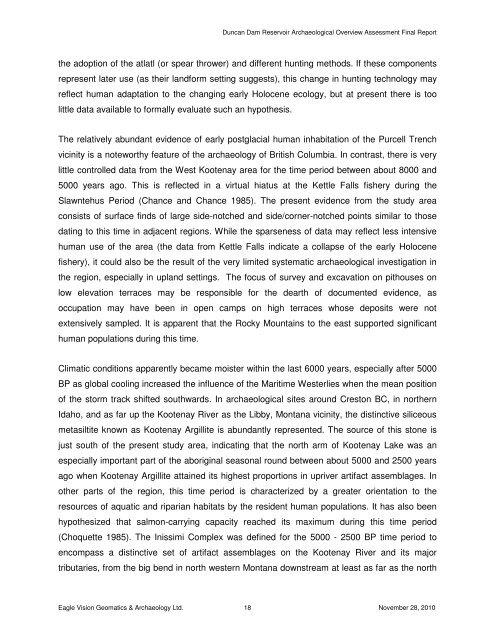November 2010 - BC Hydro
November 2010 - BC Hydro
November 2010 - BC Hydro
Create successful ePaper yourself
Turn your PDF publications into a flip-book with our unique Google optimized e-Paper software.
Duncan Dam Reservoir Archaeological Overview Assessment Final Report<br />
the adoption of the atlatl (or spear thrower) and different hunting methods. If these components<br />
represent later use (as their landform setting suggests), this change in hunting technology may<br />
reflect human adaptation to the changing early Holocene ecology, but at present there is too<br />
little data available to formally evaluate such an hypothesis.<br />
The relatively abundant evidence of early postglacial human inhabitation of the Purcell Trench<br />
vicinity is a noteworthy feature of the archaeology of British Columbia. In contrast, there is very<br />
little controlled data from the West Kootenay area for the time period between about 8000 and<br />
5000 years ago. This is reflected in a virtual hiatus at the Kettle Falls fishery during the<br />
Slawntehus Period (Chance and Chance 1985). The present evidence from the study area<br />
consists of surface finds of large side-notched and side/corner-notched points similar to those<br />
dating to this time in adjacent regions. While the sparseness of data may reflect less intensive<br />
human use of the area (the data from Kettle Falls indicate a collapse of the early Holocene<br />
fishery), it could also be the result of the very limited systematic archaeological investigation in<br />
the region, especially in upland settings. The focus of survey and excavation on pithouses on<br />
low elevation terraces may be responsible for the dearth of documented evidence, as<br />
occupation may have been in open camps on high terraces whose deposits were not<br />
extensively sampled. It is apparent that the Rocky Mountains to the east supported significant<br />
human populations during this time.<br />
Climatic conditions apparently became moister within the last 6000 years, especially after 5000<br />
BP as global cooling increased the influence of the Maritime Westerlies when the mean position<br />
of the storm track shifted southwards. In archaeological sites around Creston <strong>BC</strong>, in northern<br />
Idaho, and as far up the Kootenay River as the Libby, Montana vicinity, the distinctive siliceous<br />
metasiltite known as Kootenay Argillite is abundantly represented. The source of this stone is<br />
just south of the present study area, indicating that the north arm of Kootenay Lake was an<br />
especially important part of the aboriginal seasonal round between about 5000 and 2500 years<br />
ago when Kootenay Argillite attained its highest proportions in upriver artifact assemblages. In<br />
other parts of the region, this time period is characterized by a greater orientation to the<br />
resources of aquatic and riparian habitats by the resident human populations. It has also been<br />
hypothesized that salmon-carrying capacity reached its maximum during this time period<br />
(Choquette 1985). The Inissimi Complex was defined for the 5000 - 2500 BP time period to<br />
encompass a distinctive set of artifact assemblages on the Kootenay River and its major<br />
tributaries, from the big bend in north western Montana downstream at least as far as the north<br />
Eagle Vision Geomatics & Archaeology Ltd. 18 <strong>November</strong> 28, <strong>2010</strong>

















